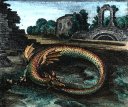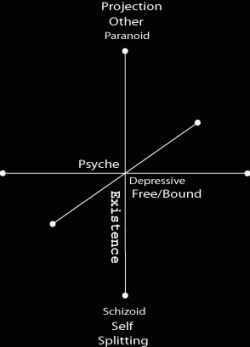July 24, 2003
Revisions to PS<->D
 | This is the dragon which devours its own tail.
|

In Alpha Function we mentioned revising the conception of the classical paranoid-schizoid and depressive positions using the more sophisticated model of human experience provided by the Cube of Psychological Space. In the classical formulation of Melanie Klein, these concepts describe both developmental states in infancy and a metapsychology of of early mental processess and instinctual development. The paranoid-schizoid position is the initial psycho-physical state of the baby, characterized by mechanisms of splitting and projection, omnipotent and destructive phantasies and part-object relationships (good breast/bad breast). The paranoid-schizoid is gradually phased out and replaced with the depressive position, as the baby learns to tolerate frustration and, depending on the amount of death instinct he or she has inherited in the form of excessive greed and envy, moves toward a realm of whole objects through the depressing realization that the world isn't all it was cracked up to be. Further disappointments lie ahead in the Oedipal stage as whole object relationships are developed and explored, and the ego (and sexual identity) is formed out of renounced object-cathexes (Freud).
|
|
Bion (projective identification) and Winnicott (transitional space) extended these concepts into the intersubjective realm and both recognized "healthy" forms of projective identification, i.e. the persistence of paranoid-schizoid processes as the basis for normal development and creativity. Psychoanalytic theory, which is the history of its resistance to intersubjectivity, seems to have reached the dead end of an over-extended and out-moded metapsychology of intra-subjective experience. It cannot assimilate its own insights into the therapeutic framework and counter-transference, and has no metapsychological framework for integrating its observations about inter-subjective phenomena. PS<->D to P<->D<->S. Here we explore just one axis of the Cube of Space, the vertical or existential axis. The Cube is a diagram or model of the multi-dimensional totality of human psychological experience. The vertical axis, analyzed by George Lakoff in Metaphors We Live By (Orientational Metaphors) and Jacques Chevalier in The Corpus and the Cortex, qualifies our experience of existence as up and down, good and bad, right and wrong, life and death, conscious and unconscious, more and less, rational and emotional (Lakoff) and right and wrong, pleasure and pain, lawful and lawless, levels of attention, judgments and emotions (Chevalier). We suggest that the root metaphor of up-down is our ex-is-tence as spirit and matter, our standing and place in the world, characterized by the polarities of self and body/other. This metaphor is clearly behind intersubjective psychoanalytic thinking, with its superegos and ids, projectition and splitting, infra and infer alter-egos, mirroring and idealizing transferences. The problem is that the components of the vertical axis are not clearly distinguished and identified. Klein lumps paranoia and schizoid phenomena together and sees depression as a later development. P: Paranoia and projection obviously have to do with the other (hysteria is a projection onto the body as other). The psyche/ego mediates between the energies of superinfraalteregoother and Now that we can see that P and S are opposite poles of existence united by the D of psyche/ego, PS->D or PS<->D can be differentiated into P<->D<->S. Notice we also differentiate self and object representations from the central ego or psyche and say nothing of consciousness or unconsciousness. Freud's Id is a narrow definition of the material basis of the self and its developmental (instinctual) goals. It is no more unconscious than any of the other unconscious energies that inform our experience of life in existence. Its direct descendents are seen in the development of the concepts self-objects, mirroring and idealizing transferences and self-psychology. PS or P<->S is the basic self-object polarity of existence. Pathologies of self relations (splitting, schizoid phenomena) and pathologies of object (why not say "other"?) relations (paranoia, positive and negative idealization) reflect imbalance or damage to either or both sides of the unit. D aka the psyche or experiencing ego is a position only in its centrality. Its integrative and dissociative functions are operative from birth. Its pathologies are mania and depression, as the central psyche tries to deal with damage to the self-object unit. P<->D<->S or object-representations <-> psyche <-> self-representations describes both the structure and dynamic of existence, present from birth. Healthy development would minimize trauma and pathology in all three positions. The depressive "position," supposedly occuring in later infancy and marking the beginning of whole-object relations, would seem to point toward a structuring of the central ego or psyche.
|
Posted by psyche at July 24, 2003 08:57 PM